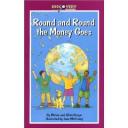Introduction and Summary
Round and Round the Money Goes (What Money Is and How We Use It) by Melvin and Gildar Berger, and illustrated by Jane McCreary, is a great resource to use when exploring economics with early elementary school students. The book provides a detailed overview of the history of money, beginning with specialization of labor and trading.
“Long ago there was no money. People grew or made everything they needed. Then things started to change. People did only one kind of work. Farmers farmed. Hunters hunted. Weavers made cloth. Woodcutters chopper wood. Now people needed other things. So they traded; potatoes for cloth, fish for meat, or fishwood for animal skins,” (pages 6-7).
Berger and Berger discuss how the problems associated with trade led to the institution of currency (the earliest of which were shells). The authors also discuss the U.S. mint, as well as the ways that people use money and the cycle of money. Berger and Berger point out the importance of saving, and provide an overview of interest, checking accounts and credit cards. “Start saving your money at home,” the authors suggest. “Find a good, safe place to keep it. After awhile bring your money to a bank…They will give it back to you when you ask for it. Banks will also give you back a little extra money. The extra money is for letting them hold your money. We call the extra money ‘interest.'”
Curriculum Connections
Round and Round the Money Goes (What Money Is and How We Use It), is a great resource to use when teaching kindergardeners, first graders, second graders, and third graders about money and the economy. Pages 32-33 provide many useful examples to share with students when learning about how people work to earn money and to buy things they want (k.7 b). Page 36 is a good resource to use when discussing how people save money for the future to purchase goods and services (1.9). The beginning part of the book, pages 3-20, can be employed at the second grade level when teaching students about the difference between the use of barter and the use of money in the exchange of resources (2.8). These pages also touch on the idea of scarcity, and how people must make choices about producing and consuming goods and services. Pages 3-20 also convey the more sophisticated concept that people and regions cannot produce everything they want, leading to the idea of specialization and trade (3.8).
Additional Resources:
-The “Fifty Nifty” economics cards and assessments found on the Federal Reserve website are a great tool to use when teaching economics. (Many games can be played, and activities can be done, using the cards. See additional activities on the right-hand side of the webpage).
-This site provides great activities to use when teaching economics in the elementary school classroom.
-This lesson plan is useful when discussing scarcity with students.
-This game is a great way to students to practice distinguishing between goods and services.
General Information:
Book: Round and Round the Money Goes (What Money Is and How We Use It)
Authors: Melvin and Gilda Berger
Illustrator: Jane McCreary
Publisher: Ideals Children's Books
Publication Date: 1993
Pages: 47
Grade Range: K-3
ISBN: 0-8249-8640-7

